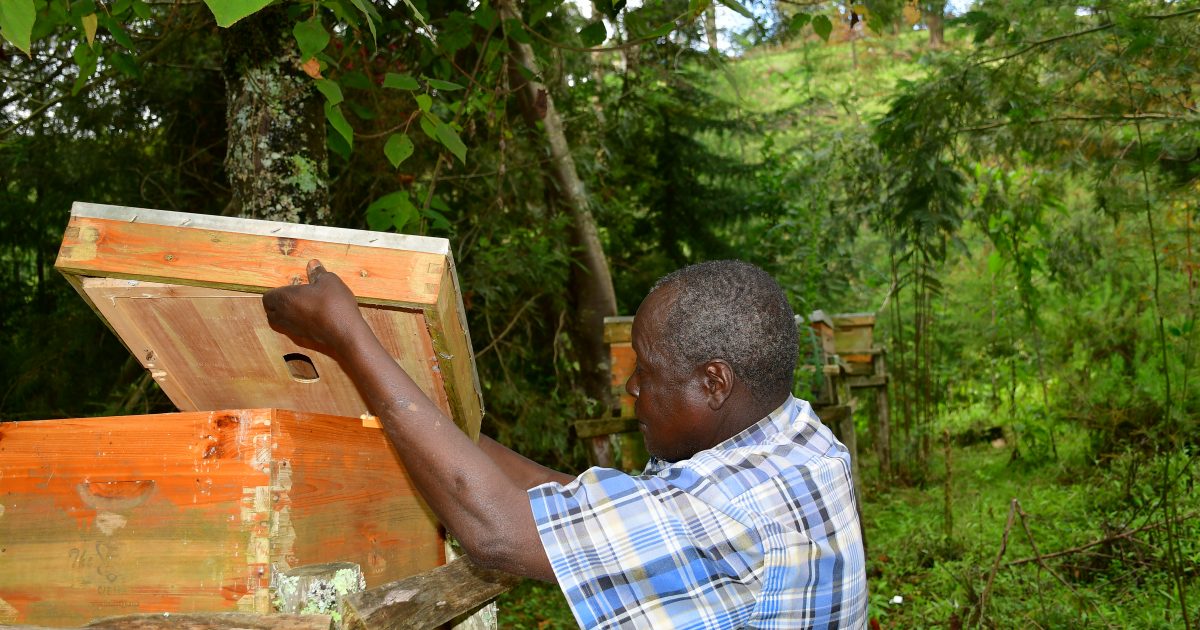Mzee William Kisang was all set for his retirement and after serving the government as a chief, he knew he wanted to practice beekeeping at his home in Kararia location of Marakwet East Sub County.
This, he says, was because it doesn’t involve hard labour and with his advancing age, he didn’t need any job that would require a lot of energy.
His passion for beekeeping was enhanced when he went for a visit to Machakos where he encountered several groups engaging in modern bee keeping project. “Most of the members were women and the elderly,” he said.
Therefore, after Mzee Kisang came home and he consulted with residents in his home area, they formed a group called Embomoi Bee Keeping Group. Mzee Kisang was however very deliberate in the formation of the group as he wanted to introduce beekeeping to the women in the area. He ensured that majority of the group members were women.

While the Marakwet community has always practiced beekeeping, they have been undertaking the traditional system where the hives are placed in the tallest trees thus, the women could not engage in the same, as they could not climb the trees traditionally.
However, with modern beekeeping, according to Mzee Kisang, hives are placed at a low level where even women could engage in the practice as they don’t have to climb any tree while harvesting or placing the hives.
The group’s chairlady Margaret Rotich said the women were excited by the idea of beekeeping saying due to its medicinal value, women were major consumers of honey.
“We believe that honey heals many ailments including inner wounds, common colds in addition to increasing milk during breastfeeding,” she said.
The group then approached the Kenya Forest Service who offered them one acre in Embobut forest where they planted indigenous trees which are good in producing nectar for bees but living next to a forest, they were able to start off their project in 2006 as they waited for the trees they had planted to grow.
“We started off with 23 local hives before increasing to 53 while after training by the Department of Livestock on modern beekeeping, we bought six modern hives at Sh7, 000 each,” he told KNA who visited him at the project.
Kisang said in 2009, they got their first harvest of 20 litres which gave them the motivation to take their business to another level.
“In 2010, we were given a Sh120, 000 loan from Uwezo Fund which we used to buy packaging materials for honey after receiving a packaging machine complete with harvesting equipment from the department of livestock,” Mzee Kipsang said.
However, three years down the line, all their dreams were shattered after the project glided to a halt and with it, an investment of approximately half a million.
Kisang says things went awry after farmers in the area started engaging in major potato farming due to its good returns. This, he said, after the collapse of pyrethrum farming leaving farmers with no major source of income.
“This being a cold area, maize does not do well and therefore it was natural for farmers to resort to potato farming which require a lot of spraying to fight blight disease and therefore heavy use of pesticides,” he said.
He said since bees collect nectar from flowers, they are easily attracted to potatoes especially during the flowering stage. He said the bees started decreasing and he had to seek professional advice from experts from the Department of Livestock and that was when he knew the bees were dying as a result of the use of pesticides.
His views were corroborated by the County Livestock Acting Director Lazurus Rutto who said the increased investment in farming and use of pesticides has affected beekeeping in the area saying bees have gradually been reducing.
The director says in the 1980s and 90s, bee keeping was a vibrant industry especially along the Marakwet highlands which is conducive for beekeeping with the government even employing officers to specifically deal with the sector but not anymore.
“Bees feed on flowers from where they get nectar and that is why they are attracted to potatoes and other crops during the flowering season. Therefore, the insecticides used in the growing of the crops kill both good and bad insects,” he said.
Ruto says the Kerio Valley has for some time been an ideal place for beekeeping but says with the establishment of irrigation projects which has increased farming activities and the continued investment in fruit farming, these have also affected the sector.
The Chief Officer Livestock and Fisheries Dr. Benson Kibore said use of banned chemicals in the country and invasive weeds which were killing indigenous trees have destabilized the ecosystem thus reducing nectar.
“We have also witnessed an increase in diseases affecting bees which majorly attack the queen bee due to an upsurge of parasites which has further affected the sector,” he said.
The CO added that the spraying of locusts also affected bees saying the chemicals used were killing all insects indiscriminately saying other alternative environment friendly interventions would have been used.
Dr. Kibore has called on the national government to increase surveillance on chemicals being imported in the country saying most of the pesticides used by the farmers were those that have been banned elsewhere.
“We are also calling on the Kenya Veterinary Board to ensure that all those trading in veterinary products are vetted and licensed so that if one is found selling any banned product, he/she can have their license withdrawn and charged,” he said.
The CO added that the county was keen in giving the beekeeping sector a boost saying that recently, they had employed a bee officer but said one officer was inadequate to offer expert advice to farmers.
The director on the other hand is calling for research on bee friendly pesticides to be used so that they could coexist with food crops saying if the situation is left unchecked, then the future of honey production is at risk.
Ruto added that the county could also consider zoning off some areas where certain activities could take place saying bees travelled a kilometer daily looking for nectar.
He says a threat to bees is a threat to food production and conservation saying bees contribute 30% of food in the world through pollination in addition to conserving the environment through conservation of forests bio diversity.
According to an article by the Food Agricultural Organisation (FAO) ‘Importance of bees in nature’, bees and most flowering plants have developed a complex interdependence during millions of years.
An estimated 80% of flowering plants are entomophilus i.e. depending more or less on insect pollination to be able to produce, and it is estimated that half of the pollinators of tropical plants are bees.
The efficiency of honeybees is due to their great numbers, their physique and their behaviour of foraging on only one plant species at one time. The bees have to find their food in flowers which could be nectar or pollen.
Nectar is produced to attract bees. Pollen also attracts bees, but it has another function too: it is produced to ensure the next generation of plants.
When enough bees are present in a forest, they provide a better pollination that leads to improved regeneration of trees and conservation of the forest’s biodiversity. The reproduction of plants is simplest as vegetative reproduction – a new tree could just come from a root shoot.
The new tree would then be genetically identical with the mother tree. Vegetative reproduction alone would be no problem if the environment were stable, but most environments are not stable as they change over time.
The instability could be as a result of climatic changes, new diseases or pests. To be able to adapt to environmental changes, there need to be genetically different plants. In that way there will always be some plants which are better adapted than others because of special genetic constitutions.
The only way to constantly mix the genes for the plants is by cross-pollination, where pollen from one plant is transported by bees to another so that the seedlings become genetically different.
In that way, there is a greater chance for at least some of the seedlings to survive in the competition of life. In this we find the bees as one of the most important factors.
By Alice Wanjiru





